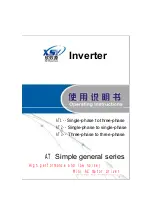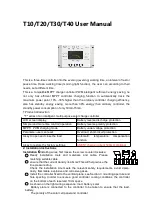
ProLine
™
�5���W�Power�Inverter�by�Wagan�Tech
®
www.wagan.com
7
©�����Wagan�Corporation.�All�Rights�Reserved.
Wagan�Tech�and�
wagan.com
�are�trademarks�used�by�Wagan�Corporation.
User’s�Manual—Read�before�using�this�equipment
8
PLANNING THE INVERTER SYSTEM
Any�large�wattage�inverter�system�requires�planning�before�installation.�There�are�
several�steps�to�the�planning�process�so�the�user�must�determine�the�following:
•� Maximum�inverter�wattage�required.
•� Operating�time�(run�time)�needed�between�battery�recharges.
•� Battery�bank�capacity�in�amp-hours.
•� Charger�requirement�to�charge�batteries�within�a�practical�time.
•� Distance�between�battery�bank�and�inverter.�
DETERMINING MAXIMUM APPLIANCE WATTAGE
Maximum�AC�appliance�wattage�is�the�first�factor�in�planning�battery�and�charging�
systems.
SOME�BACKGROUND:
Large�microwave�oven�specifications�list�cooking�power�(watts)�and�appliance�
power.�Appliance�power�is�the�AC�load�the�inverter�has�to�supply.�
Most�other�electrical�tools,�appliances�and�audio/video�equipment�have�labels�that�
list�the�unit’s�power�requirements�in�watts.�If�the�tool�or�device�is�rated�in�amps,�
multiply�the�amps�by���5�(��5V�AC)�to�determine�the�watts.�For�example,�a�power�
tool�rated�at�4�amps�will�draw�46��watts.�Determine�the�wattage�of�each�appliance�
you�need�to�simultaneously�operate.�Add�all�of�the�appliance�wattages�to�obtain�
an�estimated�“total�watts”�number.�Remember�to�consider�the�startup�surge�that�
motorized�appliances�will�cause.�Do�not�exceed�the�surge�rating�of�this�inverter�
(��,����watts)�this�can�cause�immediate�overload�shut�down.
At�5����watts�continuous�output�this�inverter�requires�a�DC�power�supply�(battery�
bank)�that�can�continuously�supply�5���amps�at���V�DC�for�the�duration�of�the�run�
time.
CONFIGURING THE BATTERY BANK
A�battery�bank�is�an�interconnection�of�batteries;�in�this�case,�to�provide����volts.�
To�determine�the�minimum�battery�ampere-hour�rating�that�you�will�need�to�operate�
appliances�from�the�inverter�and�any�DC�appliances�powered�by�the�battery�bank,�
follow�these�steps:
�.� List�the�maximum�continuous�wattage�that�an�inverter�has�to�supply.�
�.� Estimate�the�number�of�hours�each�appliance�will�be�in�use�between�battery�
recharges.�This�will�vary.�For�example,�a�typical�home-use�coffee�maker�
draws�5���watts�during�its�brew�time�of�5�minutes,�but�maintaining�pot�
temperature�only�requires�����watts.�Typically,�a�microwave�oven�only�
operates�for�a�few�minutes.�Refrigerators�and�air�conditioners�cycle�on�
and�off.�Some�longer�operating�time�appliances�are�lamps,�televisions,�
computers�and�sound�systems.
3.� Determine�the�total�watt-hours�of�energy�needed�by�multiplying�average�
power�consumption�in�watts�by�hours�of�run�time.�For�example:��5���watts�
for����hours�=��5,����watt�hours.�
4.� To�get�an�estimate�of�the�maximum�current�(in�amps)�that�a�battery�bank�
must�be�capable�of�delivering�to�the�inverter,�divide�the�AC�load�watts�by�
ten.�For�example,�a��5���watt�AC�load�will�need��5��amps�at����volts�DC.�
This�relationship�holds�for���V�DC�inverters�with�9�%�efficiency.
Using�the��5���watts�(or��5��amps)�for����hours�example,��5��amps�are�needed�
for����hours.�This�provides�us�with�the�basic�amp-hours�(AH)�of�battery�life�that�is�
required.�Ten�hours�at��5��amps�equals��5���Amp-hours�(AH).�This�answer�is�just�
a�starting�point�because�there�are�additional�factors�that�determine�actual�run�time.�
These�include:
•� Cable�gauge�and�length�(cable�losses)
•� Charge�level�of�the�batteries�(between�use,�chargers�have�to�be�able�to�fully�
charge�the�batteries)
•� Temperature�of�the�batteries�(colder�batteries�provide�fewer�amps)
•� Age�and�condition�of�the�batteries�(older�batteries�lose�AH�capacity)
•� Use�of�DC�appliances
•� Compliance�with�turning�off�unnecessary�AC�and�DC�loads.�
DERATING THE BATTERY BANK
Most�lead-acid�batteries�have�a�rating�expressed�in�amp-hours�(AH).�The�most�
common�rating�of�AH�is�“at�the����hour�rate”.�
NOTE:�Despite�several�internet�explanations,�there�is�no�relationship�between�cold�
cranking�amps�(CCA)�and�ampere-hours�(AH).
For�example;�if�a����AH�battery�is�discharged�at�a���amp�rate,�is�will�take����hours�
to�discharge�that�battery.�The�terms�“charged”�and�“discharged”�relate�to�actual�
battery�voltage.�This�means�that�the�output�voltage�of�a�nominal����volt�battery�
starts�at��3.��volts�(fully�charged)�then�drops�to���.6�volts�(discharged).�If�the�load�
on�the�battery�causes�the�battery�to�discharge�faster�than�the����hour�rate,�the�
capacity�(AH)�of�the�battery�is�measurably�reduced�(derated).�Derating�is�a�major�
run�time�factor.�The�following�curve�can�help�to�determine�what�the�battery�bank�
can�deliver�under�load.�The�results�are�used�to�estimate�how�much�additional�battery�
capacity�is�needed�to�achieve�the�desired�run�time.�
The�left�vertical�numbers�of�the�curve�represents�percentage�of�the�battery�capacity�
at�the����hour�rate.�In�this�example,�the�user�needs�a�one�hour�run�time.�If�the�
example�battery�is�����AH�(���hour�rate),�and�the�load�is�����amps�that�is����%�
(horizontal�number)�of�the�AH�(���hour�rate),�starting�at�the����%�horizontal�point�
and�looking�up�to�the�curve�the�results�are�that�only�56%�of�the�battery�capacity�is�
available.�This�means�that�a�higher�battery�capacity�is�required�to�get�the�desired�
run�time:�one�hour.�The�curve�also�shows�that�a�load�of����%�of�the����hour�rate�





























